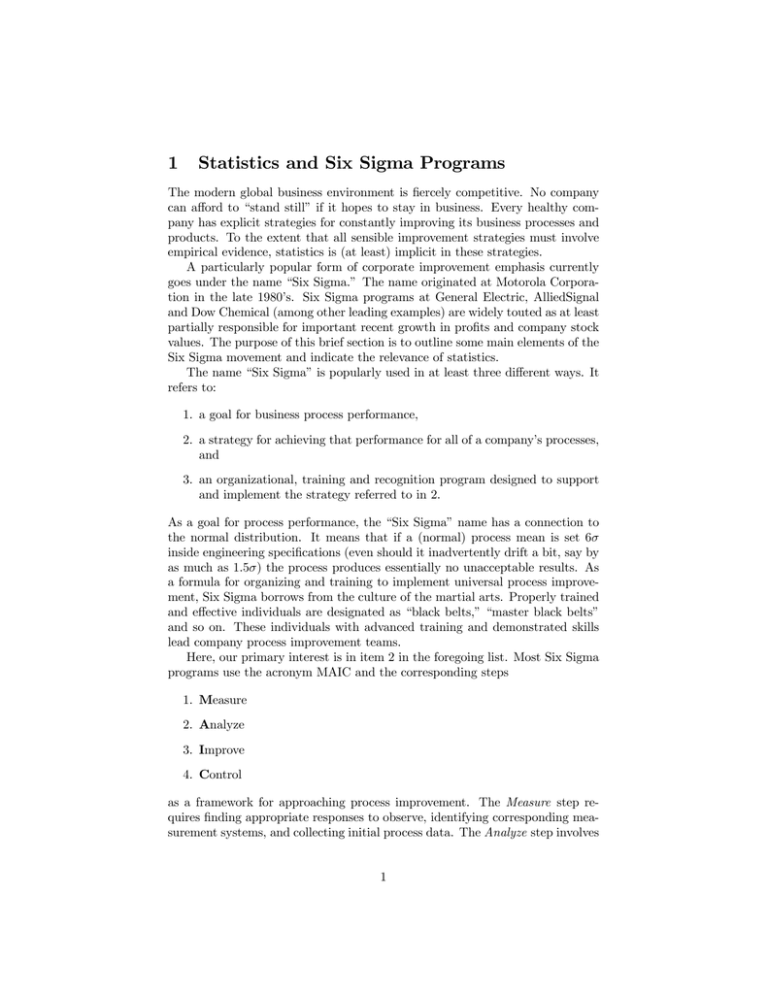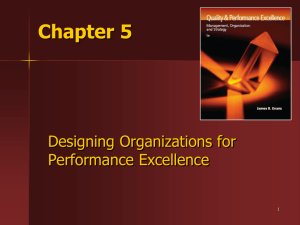1 Statistics and Six Sigma Programs
advertisement

1 Statistics and Six Sigma Programs The modern global business environment is …ercely competitive. No company can a¤ord to “stand still” if it hopes to stay in business. Every healthy company has explicit strategies for constantly improving its business processes and products. To the extent that all sensible improvement strategies must involve empirical evidence, statistics is (at least) implicit in these strategies. A particularly popular form of corporate improvement emphasis currently goes under the name “Six Sigma.” The name originated at Motorola Corporation in the late 1980’s. Six Sigma programs at General Electric, AlliedSignal and Dow Chemical (among other leading examples) are widely touted as at least partially responsible for important recent growth in pro…ts and company stock values. The purpose of this brief section is to outline some main elements of the Six Sigma movement and indicate the relevance of statistics. The name “Six Sigma” is popularly used in at least three di¤erent ways. It refers to: 1. a goal for business process performance, 2. a strategy for achieving that performance for all of a company’s processes, and 3. an organizational, training and recognition program designed to support and implement the strategy referred to in 2. As a goal for process performance, the “Six Sigma” name has a connection to the normal distribution. It means that if a (normal) process mean is set 6¾ inside engineering speci…cations (even should it inadvertently drift a bit, say by as much as 1:5¾) the process produces essentially no unacceptable results. As a formula for organizing and training to implement universal process improvement, Six Sigma borrows from the culture of the martial arts. Properly trained and e¤ective individuals are designated as “black belts,” “master black belts” and so on. These individuals with advanced training and demonstrated skills lead company process improvement teams. Here, our primary interest is in item 2 in the foregoing list. Most Six Sigma programs use the acronym MAIC and the corresponding steps 1. Measure 2. Analyze 3. Improve 4. Control as a framework for approaching process improvement. The Measure step requires …nding appropriate responses to observe, identifying corresponding measurement systems, and collecting initial process data. The Analyze step involves 1 Element Measure Analyze Improve Control Table 1: MAIC and Statistics Statistical Topics ²Measurement Concepts ²Data Collection Principles ²Regression and Linear Calibration ²Modeling Measurement Error ²Inference in Measurement Precision Studies ²Descriptive Statistics ²Normal Plotting and Capability Indices ²Statistical Intervals and Testing ²Con…dence Intervals and Testing ²Regression Analysis and Response Surface Methods ²Probabilistic Tolerancing ²Con…dence Intervals and Testing ²Factorial and Fractional Factorial Analysis ²Shewhart Control Charts producing data summaries and formal inferences adequate to make clear initial process performance. After seeing how a process is operating, there comes an Improvement e¤ort. Often this is guided by experimentation and additional data collected to see the e¤ects of changes implemented. Further, there is typically an emphasis on variation reduction (improvement in process consistency). Finally, the Six Sigma 4-step cycle culminates in process Control. This means process watching/monitoring through the routine collection and attention to process data. The point is to be sure that improvements made persist over time. The Six Sigma MAIC cycle is full of places where statistics is important. Hopefully this will be obvious as we make out way through this course. Table 1 shows in detail where standard statistical concepts and methods …t into the MAIC paradigm. 2


